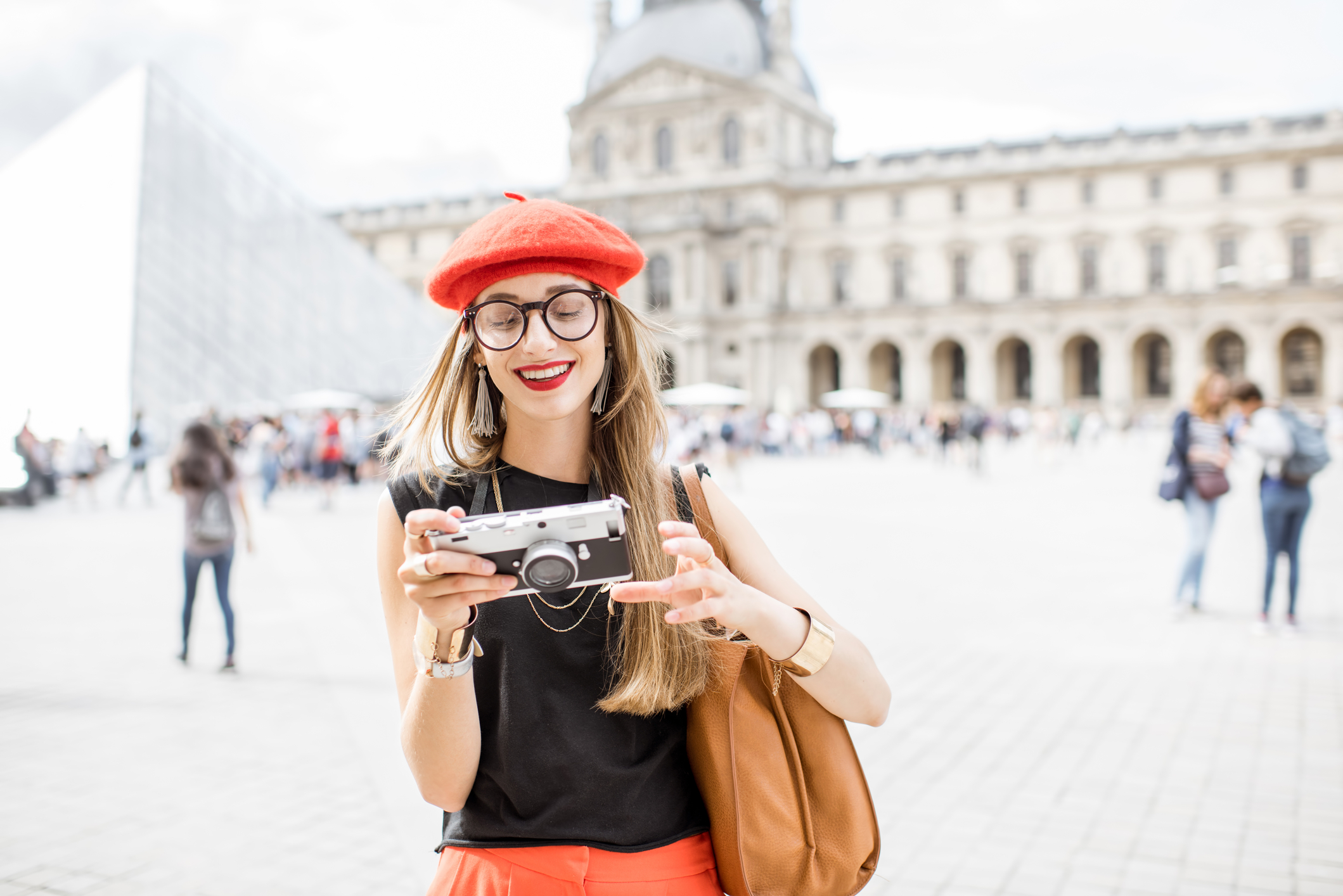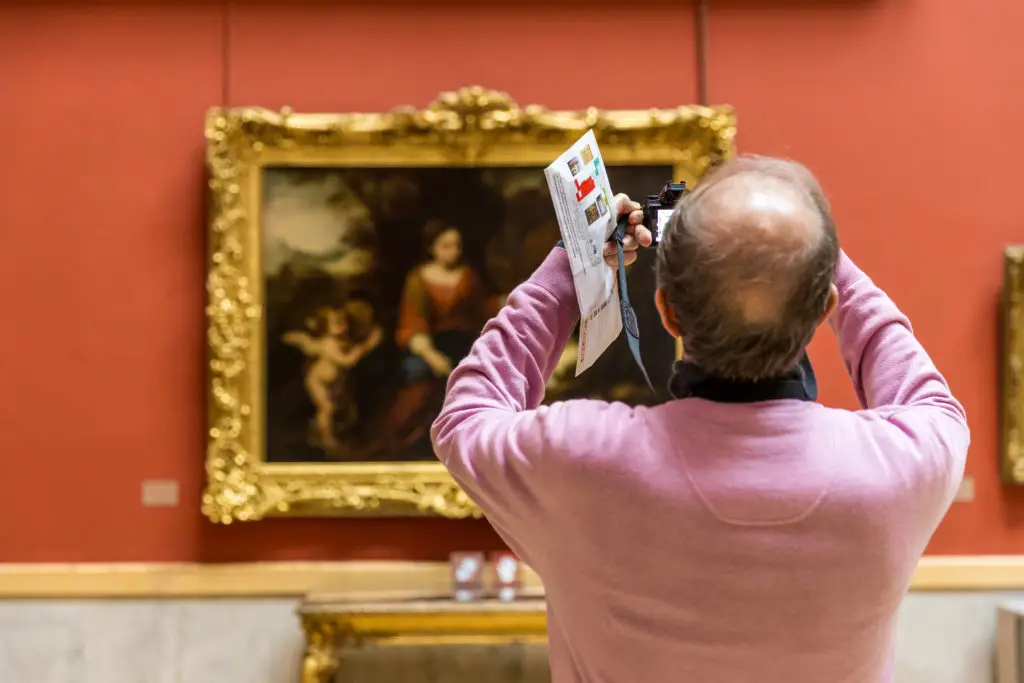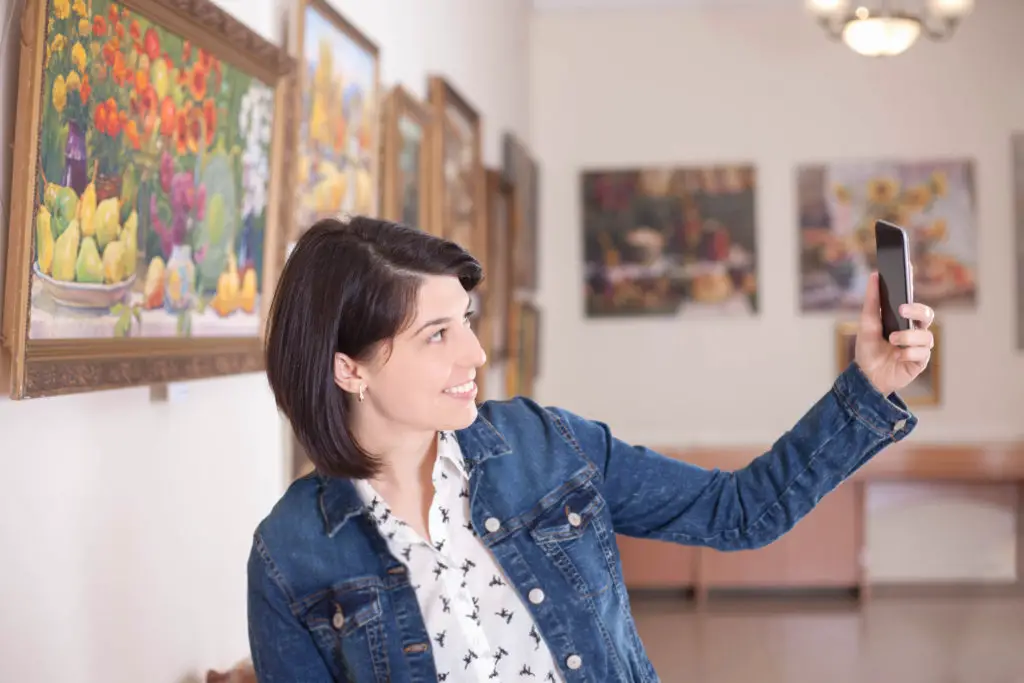If you love art, you'll want to take your own photos of the creative works you see in galleries and museums. Here's how to photograph paintings and other artwork you encounter as a visitor and art enthusiast.
To photograph a painting at an art gallery or museum, first ensure you follow the established rules. Turn off the flash on your smartphone or digital camera. Raise or lower your camera to the same height as the center of the artwork. Hold steady and trigger the shutter release as you breathe out.
To ensure you get the best results, pay attention to the balance between the painting, room lighting, your framing, the wall background, and of course, other patrons. Here are the considerations we've found to work when photographing artwork.

Rules and Guidelines
The first and most important rule is to ensure you are allowed to photograph the artwork in the museum or gallery.
Ask the staff for the guidelines around photos and videos of the paintings. Some exhibits do not permit patrons to take pictures at all. Others exhibits allow photographing the paintings without the use of flash.
Note:
In his paper "Amateur Photographers in Art Galleries: Assessing the harm done by flash photography," Martin H. Evans evaluates the impact of photographic flashes on art. While there are other reasons to prohibit the use of flash in museums and galleries, Evans found that modern flash technology does not pose a significant threat to even the oldest works.
The paper attempts to guess alternative reasons behind barring (flash) photography or videography, which includes
- avoidance of copyright infringement
- interference with security systems
- thwarting criminal planning
- impact on souvenir or gift shop sales
- discomfort to other patrons
Despite the apparent or advertised reasons behind the banning of photographic recording of gallery or museum art, patrons should remain within the guidelines of what art pieces or sections are off-limits to photography.
Other Patrons
Always be respectful of other patrons. It's reasonable to expect that you will not be the only one taking photos of the paintings in a gallery or museum.
Watch for others taking their own photos. Give visitors time to take their pictures and avoid the sense of rush or impatience.
Watch behind you when backing up to frame your shot so you don't bump into someone. And if you notice someone stepping into your picture when photographing art, respectfully ask the person to step aside or wait for your shot to clear. The chances are that they didn't realize that you were taking a photo.
Behind Glass or Protective Enclosures
It is always tricky to photograph paintings that are behind glass. You need to find the right angle to avoid any glare.
Try different angles until you find the shot without any glare or with the least possible reflection.
Of course, using a camera flash will never work when photographing paintings through the glass. The flash bounces off the glass, creating an overexposed area and often accentuates fingerprints, streaks, or imperfections in the glass enclosure.
By the way:
Always try to keep your own art clean whether it's on display in a gallery or simply at home. Check out our tips for cleaning various types of paintings and other wall art.
If you're unable to find an angle where a reflection is minimized, it may be best to simply enjoy the moment before moving on without a photo. Alternatively, a friend can help by blocking reflected light, causing the glare.
A professional or prosumer DSLR camera with manual focus control can focus past glass enclosures. This requires you to photograph the painting from close. And if permissible, rest the camera lens's glare hood on the glass to stabilize the shot.

Lighting
A variety of camera settings can make or break a photo of a beloved art piece.
First, consider the lighting of the exhibition rooms as you travel around the venue. Traditional museum lighting tends to be darker or use indirect room lighting. Museum curators guard against direct sunlight and other natural light sources that may damage historical pieces. Modern galleries favor brighter room lighting and sometimes include direct lighting on the artwork. Lighting may also be used to set a mood or highlight the type of materials.
Read more on lighting: 9 Tips On How To Light Wall Art [Advice For Collectors At Home]
In addition to the photographer's trinity (aperture, shutter speed, and ISO), be sure to adjust the white balance. Some artists present their work in lighting filtered to enhance the emotion of the painting. Adjusting white balance allows your photo to stay true to the colors displayed in person. Most automatic camera settings will produce a good white balance configuration. A professional photographer may use a gray card to get a custom white balance. But however it's achieved, after adjusting your white balance, take early test shots until you're happy with the results.
Once you have the proper settings, you should be good to go for the whole visit. When you enter a new exhibition room or a different wing of the museum, note if the lighting conditions changed and take some new test shots. Alternatively, step aside and review your latest photos to ensure they're to your liking before leaving a section of the gallery.
Remember to use good photographer's techniques as you record your visit.
Small Pieces & Tight Spaces
Photographing artwork, especially smaller art pieces, requires you to get up close and fill the frame with the painting.
Many famous pieces are smaller than you think, and often a close shot isn't possible. For example, we made the obligatory visit to the Mona Lisa by Leonardo da Vinci, a surprisingly small painting. Exhibition ushers did not permit close viewing, and with a large number of visitors queued, a good shot was tricky. I wished I had brought my DSLR camera with a zoom lens. On the other hand, it was worth making a memory with our family instead of worrying about how to photograph art throughout the visit.

In tight spaces, use a wide-angle or prime lens with a shorter focal length. These lenses allow you to capture a view at a closer range. Otherwise, choose an interesting angle to take your photo of the artwork.
Too Large For Your Shot
You usually want to take the photo directly aligned to the center of the painting.
When a piece is too large to fit in your shot and stepping further back away from the subject is impossible, consider other interesting or artistic angles. Some paintings look beautiful when viewed from a 45-degree angle. Others give off a different mood when viewed from a lower angle, looking up.
There are many angles from which you can take a beautiful picture of a painting. This might even be a great time to include a selfie.
Selfies
Selfies are a great way to make a painting and your visit personal and memorable. It's always great to look back and remind yourself how special it was to be in the presence of a masterwork.
While the trend is less popular now, avoid selfie sticks at all costs. A selfie stick allows you to frame more of the scene in your photo. These sticks have become a nuisance to many galleries and museums alike. Patrons using selfie sticks often interfere with other visitors, especially in smaller exhibit rooms.

It's far better to take the selfie at arm's length, or even better, ask another patron to take a picture of you and the painting. Other art goers are often more than happy to help. You might offer to return the favor or strike up a small conversation over the artwork.
Sharing on Social Media
Many people want to share their experience of a famous museum, gallery, or master artwork, especially in an age of social sharing. But please wait until after your visit to share your photos and video stories on social media.
Sharing your media on social networks usually requires several steps: titling, captioning, tagging, applying filters, and posting. These processes distract you from your surroundings. Don't be busy with social media and stand in the way of other visitors trying to enjoy the painting.
If you really want to post your photograph immediately, step aside and find a bench or exhibit room corner out of the way of viewers. Ensuring you're no longer in the way allows you to take your time to post to your social platforms.
Remember:
Visiting galleries and museums are about being present enjoying the art. Take it all in and embrace the inspiration, emotion, and viewpoints while in the presence of masterworks of art.